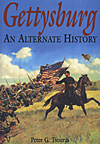 Greenhill, 2002, £ 12.95, ISBN 1-85367-482-6, 320 pgs., trade softback
Greenhill, 2002, £ 12.95, ISBN 1-85367-482-6, 320 pgs., trade softback
If you missed the hardcover version from 1997, then here's your chance to pick up the softcover. I believe this book was banned from the book store at the Gettysburg Visitor's Center. I can see why. In an age when one-third of high school students don't know who we fought during the American Revolution or why or when the American Civil War occurred, and a goodly portion of adults think Disney's Atlantis was a documentary, placing a book proposing an alternate battle of Gettysburg in a National Park book store would confuse an already uninformed general public.
Those of use who refight historical battles across computer screen, miniatures tabletop, and boardgame map will enjoy, nay, drool, over Tsouras' sort of mental exercise. Tsouras weaves a pretty good scenario by positing that Longstreet did a flank march around the Round Tops on the second day that came within a hair's breadth of success, and that Pickett and what was left of Ewell and Longstreet did a concentrated and concerted charge up the middle on the third day.
As far as the prose goes, it's not Killer Angels, but give Tsouras some credit here. He duplicates the same anecdote-laced, battle-scene heavy style found in most history books, punctuated by diary extracts, letters, and memoirs. It's all "properly" footnoted, even though many footnotes are totally fictitious. This is after all, a work of fiction. If I have one nit to pick, it's that the prose tends to overwhelm you with information--names and units fly at you faster then balls from double-canister. If you're a civil war expert, you'll eat this up. If, like me, you do not carry the complete Union and Confederate roster in brain RAM, you will find yourself lost at times.
As a result, I sometimes found myself re-reading paragraphs as yet more units pour yet more fire into yet more opponents. A pause now and again, or just more detailed maps, would help catch our mental breath. The maps do help slightly, although quite often the names on the map don't correspond to the names I'm reading, as they are higher formations. Again, it's the brain RAM roster syndrome. Tsouras knows the units inside and out, but for us mere mortals, well, we tend to wander a bit. When you're reading an alternative history, you need to give your audience a breather and be absolutely crystal clear about who's doing what.
Of course, I had to chuckle a bit when I read about Brig. Gen. Henry H. Lockwood and his Maryland brigade. In two West Point-style "map and miniatures wargame" replays of the battle of Gettysburg, the umpire always makes me command that unit, even though I can definitely state the likelihood of his being my direct ancestor is nil, and of an indirect ancestor is slim. But I did enjoy reading about a Lockwood full of fire and brimstone.
Tsouras has written or edited a number of the alternate histories and Gettysburg is a strong effort. The stronger your interest and knowledge of this great battle, the more you will enjoy this book. I know I did.
Back to List of Book Reviews: American Civil War
Back to Master Book Review List
Back to Master Magazine List
© Copyright 2002 by Coalition Web, Inc.
This article appears in MagWeb.com (Magazine Web) on the Internet World Wide Web.
Other military history articles and gaming articles are available at http://www.magweb.com